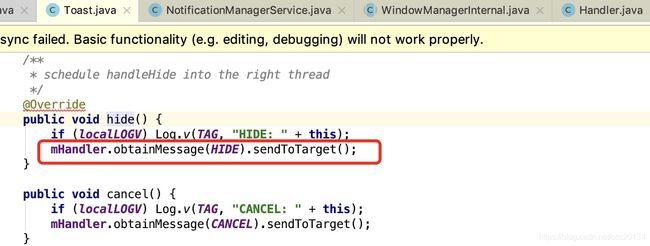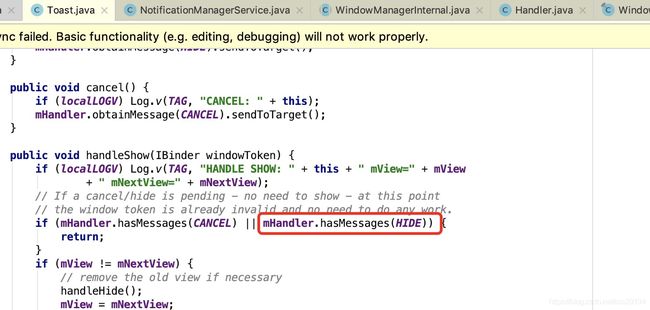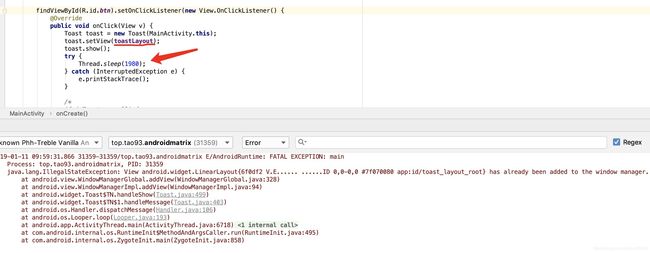Android--Toast 两个 Crash
Android Toast 两个 Crash
地址:http://tao93.top/2018/12/22/Android%20Toast%20%E4%B8%A4%E4%B8%AA%20Crash/
Toast 是 Android 系统一种非常简单的提示性小工具,最近我尝试修复 Toast 相关的两种 Crash,所以把相关的原委和过程记录了下来。先来看一下第一种 Crash 的 log:
1 2 3 4 5 6 7 8 9 10 |
android.view.WindowManager$BadTokenException: Unable to add window -- token android.os.BinderProxy@e2815e is not valid; is your activity running?
at android.view.ViewRootImpl.setView(ViewRootImpl.java:679)
at android.view.WindowManagerGlobal.addView(WindowManagerGlobal.java:342)
at android.view.WindowManagerImpl.addView(WindowManagerImpl.java:93)
at android.widget.Toast$TN.handleShow(Toast.java:459)
at android.widget.Toast$TN$2.handleMessage(Toast.java:342)
at android.os.Handler.dispatchMessage(Handler.java:102)
at android.os.Looper.loop(Looper.java:154)
at android.app.ActivityThread.main(ActivityThread.java:6119)
at java.lang.reflect.Method.invoke(Native Method)
|
上面的 stack trace 中的代码全部是关于 UI 线程中处理一个消息的,这个消息需要做的是把 Toast 需要显示的 view 添加到 WindowManager 中,从而可以显示出来。这样的 crash 是没有任何 app 代码牵涉其中的,所以无法确定是 app 何处的代码导致的这个 crash。我们先来看看 Toast 显示的大致过程。
首先是通过 Toast#makeText 方法或者 Toast 构造函数创建 Toast 对象,然后就可以调用它的 show 方法了。不过此方法是异步的,它仅仅是将该 toast 添加到一个队列中,等待显示,即此方法不等 toast 真正显示就已经返回了,而 toast 的显示需要用一个新的 UI 线程消息中的代码来显示出来。
Toast#show 方法:
1 2 3 4 5 6 7 8 9 10 11 12 13 14 15 16 17 18 19 |
/**
* Show the view for the specified duration.
*/
public void show() {
if (mNextView == null) {
throw new RuntimeException("setView must have been called");
}
INotificationManager service = getService();
String pkg = mContext.getOpPackageName();
TN tn = mTN;
tn.mNextView = mNextView;
try {
service.enqueueToast(pkg, tn, mDuration);
} catch (RemoteException e) {
// Empty
}
}
|
上面代码的第 15 行是一个跨进程调用了 NotificationServiceManager 的方法,而作为参数的 TN 对象是实现了 IInterface 的,所以可以通过 Binder 传给其他进程。Toast 真正的显示,需要等 NotificationServiceManager 回调回来,这个回调也就是调用 Toast 内部类 TN 的 show 方法。而从 api 25 开始,此方法还会将 NotificationServiceManager 产生的一个 window token 传递过来。
api 25 中的 TN#show 方法:
1 2 3 4 5 6 7 8 |
/**
* schedule handleShow into the right thread
*/
@Override
public void show(IBinder windowToken) {
if (localLOGV) Log.v(TAG, "SHOW: " + this);
mHandler.obtainMessage(0, windowToken).sendToTarget();
}
|
api 24 中的 TN#show 方法:
1 2 3 4 5 6 7 8 |
/**
* schedule handleShow into the right thread
*/
@Override
public void show() {
if (localLOGV) Log.v(TAG, "SHOW: " + this);
mHandler.post(mShow);
}
|
此 TN#show 方法是被远程调用的,所以实际会运行在 app 的 Binder 线程池的线程中,所以此方法向主线程发了一个消息,这个消息才是真正让 toast 显示的地方。不同的是 api 25 的代码还会把 window token 也传递到消息中。处理这个消息的代码,会调用 TN#handleShow 方法,这个 handleShow 是下面这样的:
1 2 3 4 5 6 7 8 9 10 11 12 13 14 15 16 17 18 19 20 21 22 23 24 25 26 27 28 29 30 31 32 33 34 35 36 37 38 39 40 |
public void handleShow() {
if (localLOGV) Log.v(TAG, "HANDLE SHOW: " + this + " mView=" + mView
+ " mNextView=" + mNextView);
if (mView != mNextView) {
// remove the old view if necessary
handleHide();
mView = mNextView;
Context context = mView.getContext().getApplicationContext();
String packageName = mView.getContext().getOpPackageName();
if (context == null) {
context = mView.getContext();
}
mWM = (WindowManager)context.getSystemService(Context.WINDOW_SERVICE);
// We can resolve the Gravity here by using the Locale for getting
// the layout direction
final Configuration config = mView.getContext().getResources().getConfiguration();
final int gravity = Gravity.getAbsoluteGravity(mGravity, config.getLayoutDirection());
mParams.gravity = gravity;
if ((gravity & Gravity.HORIZONTAL_GRAVITY_MASK) == Gravity.FILL_HORIZONTAL) {
mParams.horizontalWeight = 1.0f;
}
if ((gravity & Gravity.VERTICAL_GRAVITY_MASK) == Gravity.FILL_VERTICAL) {
mParams.verticalWeight = 1.0f;
}
mParams.x = mX;
mParams.y = mY;
mParams.verticalMargin = mVerticalMargin;
mParams.horizontalMargin = mHorizontalMargin;
mParams.packageName = packageName;
mParams.removeTimeoutMilliseconds = mDuration ==
Toast.LENGTH_LONG ? LONG_DURATION_TIMEOUT : SHORT_DURATION_TIMEOUT;
if (mView.getParent() != null) {
if (localLOGV) Log.v(TAG, "REMOVE! " + mView + " in " + this);
mWM.removeView(mView);
}
if (localLOGV) Log.v(TAG, "ADD! " + mView + " in " + this);
mWM.addView(mView, mParams);
trySendAccessibilityEvent();
}
}
|
上面代码的第 37 行,才是真正把 toast 的 view 添加到 WindowManager,也就是让 toast 显示出来,至此理了一遍 toast 显示的流程。而最前面的 crash log 表明,crash 是发生在 ViewRootImpl#setView 方法中的,并且提示 window token invalid。这其实就是提示 从 NotificationManagerService 传过来给 TN 的 token 对象失效了。而失效的原因,其实得从 NotificationManagerService 中找。
NotificationManagerService#showNextToastLocked 方法:
1 2 3 4 5 6 7 8 9 10 11 12 13 14 15 16 17 18 19 20 21 22 23 24 25 |
void showNextToastLocked() {
ToastRecord record = mToastQueue.get(0);
while (record != null) {
if (DBG) Slog.d(TAG, "Show pkg=" + record.pkg + " callback=" + record.callback);
try {
record.callback.show(record.token);
scheduleTimeoutLocked(record);
return;
} catch (RemoteException e) {
Slog.w(TAG, "Object died trying to show notification " + record.callback
+ " in package " + record.pkg);
// remove it from the list and let the process die
int index = mToastQueue.indexOf(record);
if (index >= 0) {
mToastQueue.remove(index);
}
keepProcessAliveIfNeededLocked(record.pid);
if (mToastQueue.size() > 0) {
record = mToastQueue.get(0);
} else {
record = null;
}
}
}
}
|
此方法就是 NotificationManagerService 发起显示下一个 toast 的代码,注意到第 6 行调用的 show 方法,其实就是远程调用 TN 对象的 show 方法,而第 6 行的 callback 其实就是 TN 对象所对应的远程代理对象。紧接着第 7 行调用的 scheduleTimeoutLocked 方法,其实设定了一个失效限制,使得第 6 行传递的 token 会在几秒内失效。
scheduleTimeoutLocked 方法
1 2 3 4 5 6 7 |
private void scheduleTimeoutLocked(ToastRecord r)
{
mHandler.removeCallbacksAndMessages(r);
Message m = Message.obtain(mHandler, MESSAGE_TIMEOUT, r);
long delay = r.duration == Toast.LENGTH_LONG ? LONG_DELAY : SHORT_DELAY;
mHandler.sendMessageDelayed(m, delay);
}
|
上面代码发送一个 delayed 消息(截止 api 27,此 delay 时长是 2 秒或 3.5 秒),处理上面方法发送的消息的代码:
1 2 3 4 5 6 7 8 9 10 11 |
@Override
public void handleMessage(Message msg)
{
switch (msg.what)
{
case MESSAGE_TIMEOUT:
handleTimeout((ToastRecord)msg.obj);
break;
...
}
}
|
上面被调用的 handleTimeOut 方法:
1 2 3 4 5 6 7 8 9 10 |
private void handleTimeout(ToastRecord record)
{
if (DBG) Slog.d(TAG, "Timeout pkg=" + record.pkg + " callback=" + record.callback);
synchronized (mToastQueue) {
int index = indexOfToastLocked(record.pkg, record.callback);
if (index >= 0) {
cancelToastLocked(index);
}
}
}
|
上面第 7 行被调用的 cancelToastLocked 方法:
1 2 3 4 5 6 7 8 9 10 11 12 13 14 15 16 17 18 19 20 21 22 |
void cancelToastLocked(int index) {
ToastRecord record = mToastQueue.get(index);
try {
record.callback.hide();
} catch (RemoteException e) {
Slog.w(TAG, "Object died trying to hide notification " + record.callback
+ " in package " + record.pkg);
// don't worry about this, we're about to remove it from
// the list anyway
}
ToastRecord lastToast = mToastQueue.remove(index);
mWindowManagerInternal.removeWindowToken(lastToast.token, true, DEFAULT_DISPLAY);
keepProcessAliveIfNeededLocked(record.pid);
if (mToastQueue.size() > 0) {
// Show the next one. If the callback fails, this will remove
// it from the list, so don't assume that the list hasn't changed
// after this point.
showNextToastLocked();
}
}
|
上面第 13 行就是使 window token 失效的代码。至此可知,NotificationServiceManager 远程调用 TN#show 方法后几秒内,此 token 就会失效,在这几秒内如果 toast 没有真正添加到 WindowManager,那么等添加的时候,就会出现 BadTokenException,应用就会 crash。而阻碍 toast 的 view 被添加到 WindowManager,只有 UI 线程的忙碌,也就是如果 UI 线程已经在执行或者马上要执行的其他消息比较耗时,那么 toast 的 view 就无法及时添加。
不过,Google 也意识到这种 UI 线程 block 不到 ANR 时长就 crash 的现象了,所以在 api 26 中,此 BadTokenException 直接被捕获了,也就是下面的第 42 行:
1 2 3 4 5 6 7 8 9 10 11 12 13 14 15 16 17 |
public void handleShow(IBinder windowToken) {
...
if (mView != mNextView) {
...
if (localLOGV) Log.v(TAG, "ADD! " + mView + " in " + this);
// Since the notification manager service cancels the token right
// after it notifies us to cancel the toast there is an inherent
// race and we may attempt to add a window after the token has been
// invalidated. Let us hedge against that.
try {
mWM.addView(mView, mParams);
trySendAccessibilityEvent();
} catch (WindowManager.BadTokenException e) {
/* ignore */
}
}
}
|
所以此 crash,仅仅发生在 api 25 的系统中,要修复这个问题,可以参考 github 上的 ToastCompat 中的方法。
再来看一下另一种 Crash log:
1 2 3 4 5 6 7 8 9 10 11 12 13 14 |
java.lang.IllegalStateException: View android.widget.LinearLayout{41a97eb8 V.E..... ......ID 0,0-540,105 #7f0b020d app:id/toast_layout_root} has already been added to the window manager.
at android.view.WindowManagerGlobal.addView(WindowManagerGlobal.java:223)
at android.view.WindowManagerImpl.addView(WindowManagerImpl.java:69)
at android.widget.Toast$TN.handleShow(Toast.java:402)
at android.widget.Toast$TN$1.run(Toast.java:310)
at android.os.Handler.handleCallback(Handler.java:730)
at android.os.Handler.dispatchMessage(Handler.java:92)
at android.os.Looper.loop(Looper.java:137)
at android.app.ActivityThread.main(ActivityThread.java:5136)
at java.lang.reflect.Method.invokeNative(Method.java)
at java.lang.reflect.Method.invoke(Method.java:525)
at com.android.internal.os.ZygoteInit$MethodAndArgsCaller.run(ZygoteInit.java:737)
at com.android.internal.os.ZygoteInit.main(ZygoteInit.java:553)
at dalvik.system.NativeStart.main(NativeStart.java)
|
这个 crash 原因是同一个 view 被重复添加到 WindowManager 导致的。抛出异常的地方是 WindowManagerGlobal#addView 方法,也就是下面的代码第 15 行:
1 2 3 4 5 6 7 8 9 10 11 12 13 14 15 16 17 18 19 20 |
public void addView(View view, ViewGroup.LayoutParams params,
Display display, Window parentWindow) {
if (view == null) {
throw new IllegalArgumentException("view must not be null");
}
if (display == null) {
throw new IllegalArgumentException("display must not be null");
}
...
int index = findViewLocked(view, false);
if (index >= 0) {
if (mDyingViews.contains(view)) {
// Don't wait for MSG_DIE to make it's way through root's queue.
mRoots.get(index).doDie();
} else {
throw new IllegalStateException("View " + view
+ " has already been added to the window manager.");
}
// The previous removeView() had not completed executing. Now it has.
}
|
从上面代码可知,第 10 行 index 非负,且 mDyingViews 包含需添加的 view,则会抛出此异常。第 10 行 index 非负的原因,是 mViews 包含此 view,如下面代码所示:
1 2 3 4 5 6 7 |
private int findViewLocked(View view, boolean required) {
final int index = mViews.indexOf(view);
if (required && index < 0) {
throw new IllegalArgumentException("View=" + view + " not attached to window manager");
}
return index;
}
|
所以,也就是当需要添加一个 view 时,如果此 view 在 mViews 中却不在 mDyingViews 中,那就会抛出异常。现在我们看一下 Toast#TN#handleShow 方法:
1 2 3 4 5 6 7 8 9 10 11 12 13 14 15 16 17 18 19 20 21 |
public void handleShow(IBinder windowToken) {
...
if (mView != mNextView) {
...
if (mView.getParent() != null) {
if (localLOGV) Log.v(TAG, "REMOVE! " + mView + " in " + this);
mWM.removeView(mView);
}
if (localLOGV) Log.v(TAG, "ADD! " + mView + " in " + this);
// Since the notification manager service cancels the token right
// after it notifies us to cancel the toast there is an inherent
// race and we may attempt to add a window after the token has been
// invalidated. Let us hedge against that.
try {
mWM.addView(mView, mParams);
trySendAccessibilityEvent();
} catch (WindowManager.BadTokenException e) {
/* ignore */
}
}
}
|
上面代码显示,实际上,Toast 被现实时,其实会先把 view 从 WindowManager 移除(注意一下移除的前提是 view 的 parent 不空),然后再尝试添加。我们看看 WindowManagerGlobal#removeView 方法:
1 2 3 4 5 6 7 8 9 10 11 12 13 14 15 16 17 |
public void removeView(View view, boolean immediate) {
if (view == null) {
throw new IllegalArgumentException("view must not be null");
}
synchronized (mLock) {
int index = findViewLocked(view, true);
View curView = mRoots.get(index).getView();
removeViewLocked(index, immediate);
if (curView == view) {
return;
}
throw new IllegalStateException("Calling with view " + view
+ " but the ViewAncestor is attached to " + curView);
}
}
|
需要注意上面方法有个 immediate 参数,不过从 Toast#TN#handleShow 调用过来时,这个参数会是 false。现在假设 view 包含在 mViews 中,那么上面第 7 行 index 将非负,上面第 9 行调用了 removeViewLocked 方法:
1 2 3 4 5 6 7 8 9 10 11 12 13 14 15 16 17 18 |
private void removeViewLocked(int index, boolean immediate) {
ViewRootImpl root = mRoots.get(index);
View view = root.getView();
if (view != null) {
InputMethodManager imm = InputMethodManager.getInstance();
if (imm != null) {
imm.windowDismissed(mViews.get(index).getWindowToken());
}
}
boolean deferred = root.die(immediate);
if (view != null) {
view.assignParent(null);
if (deferred) {
mDyingViews.add(view);
}
}
}
|
上面代码 第 11 行因为 immediate 为 false,所以返回的 deferred 是 true,那么第 15 行就会把 view 添加到 mDyingViews。
至此总结一下,只要 view 的 parent 不空,那么它就会尝试被移除,如果 mView是中有次 view,则尝试移除的结果就是 mDyingViews 也会包含此 view,则 crash 不会发生。
经过分析系统代码,我发现给 view 设置 parent 是在 ViewRootImpl 中的 setView 方法调用 view.assignParent(this) 做到的,而 ViewRootImpl #setView 是在 WindowManagerGlobal#addView 调用的。置空 parent 则是在 WindowManagerGlobal#removeViewLocked 做的,而从 mViews 移除 view 是在 WindowManagerGlobal#doRemoveView 做的:
1 2 3 4 5 6 7 8 9 10 11 12 13 14 |
void doRemoveView(ViewRootImpl root) {
synchronized (mLock) {
final int index = mRoots.indexOf(root);
if (index >= 0) {
mRoots.remove(index);
mParams.remove(index);
final View view = mViews.remove(index);
mDyingViews.remove(view);
}
}
if (ThreadedRenderer.sTrimForeground && ThreadedRenderer.isAvailable()) {
doTrimForeground();
}
}
|
由于这些方法都是在主线程调用的,所以可以肯定,在 addView 时,mView 包含 view 时,则此 view 的 parent不空。而 mView 不包含 view 时,它的 parent 为空。看起来似乎无懈可击,系统代码确保了 toast 的显示不会出现重复添加 view 导致的 IllegalStateException。但是明明 crash 就是发生了,分析堆栈也可知就是出现了 view 在 mViews 中但却不在 mDyingViews 中的情况。
经过分析,我可能找到了一种原因。先来看 WindowManagerGlobal#addView 方法:
1 2 3 4 5 6 7 8 9 10 11 12 13 14 15 16 17 18 19 20 21 22 23 24 25 26 27 28 29 30 31 32 33 34 35 36 37 38 39 40 |
public void addView(View view, ViewGroup.LayoutParams params,
Display display, Window parentWindow) {
...
ViewRootImpl root;
View panelParentView = null;
synchronized (mLock) {
...
int index = findViewLocked(view, false);
if (index >= 0) {
if (mDyingViews.contains(view)) {
// Don't wait for MSG_DIE to make it's way through root's queue.
mRoots.get(index).doDie();
} else {
throw new IllegalStateException("View " + view
+ " has already been added to the window manager.");
}
// The previous removeView() had not completed executing. Now it has.
}
...
root = new ViewRootImpl(view.getContext(), display);
view.setLayoutParams(wparams);
mViews.add(view);
mRoots.add(root);
mParams.add(wparams);
// do this last because it fires off messages to start doing things
try {
root.setView(view, wparams, panelParentView);
} catch (RuntimeException e) {
// BadTokenException or InvalidDisplayException, clean up.
if (index >= 0) {
removeViewLocked(index, true);
}
throw e;
}
}
}
|
首先上面代码可能存在一处漏洞。假设 view 之前从未添加过,那么低 9 行返回 -1,第 25 至 27 行把 view 添加到了 mViews 中,然后假设此 view 添加过程中失败了,即第 31 行抛出了异常,可是此时 index 是 -1,所以第 15 行企图移除此 view 是做不到的,于是此 view 就留在了 mViews 中,这可能是系统的移除漏洞。另一种情况,假设第 9 行返回非负值,那么此 view 在第 13 行会立即移除,第 25 行重新添加到 mView 中时,此 view 新的 index 已经不是第 9 行的值了,然后如果第 31 行添加失败,那么第 35 行将会被执行,可是 index 是错误的,这将会导致错误的 view 被移除!
上面可能的漏洞要发生,需要第 35 行抛出异常,而查看 ViewRootImpl#setView 方法可知,如果异常抛出,那么 view 的 parent 将尚未设置:
1 2 3 4 5 6 7 8 9 10 11 12 13 14 15 16 17 18 19 20 21 22 23 24 25 26 27 28 29 30 31 32 33 34 35 36 37 38 39 40 41 42 43 44 45 46 47 48 49 50 51 52 53 54 55 56 57 |
public void setView(View view, WindowManager.LayoutParams attrs, View panelParentView) {
synchronized (this) {
if (mView == null) {
...
if (res < WindowManagerGlobal.ADD_OKAY) {
mAttachInfo.mRootView = null;
mAdded = false;
mFallbackEventHandler.setView(null);
unscheduleTraversals();
setAccessibilityFocus(null, null);
switch (res) {
case WindowManagerGlobal.ADD_BAD_APP_TOKEN:
case WindowManagerGlobal.ADD_BAD_SUBWINDOW_TOKEN:
throw new WindowManager.BadTokenException(
"Unable to add window -- token " + attrs.token
+ " is not valid; is your activity running?");
case WindowManagerGlobal.ADD_NOT_APP_TOKEN:
throw new WindowManager.BadTokenException(
"Unable to add window -- token " + attrs.token
+ " is not for an application");
case WindowManagerGlobal.ADD_APP_EXITING:
throw new WindowManager.BadTokenException(
"Unable to add window -- app for token " + attrs.token
+ " is exiting");
case WindowManagerGlobal.ADD_DUPLICATE_ADD:
throw new WindowManager.BadTokenException(
"Unable to add window -- window " + mWindow
+ " has already been added");
case WindowManagerGlobal.ADD_STARTING_NOT_NEEDED:
// Silently ignore -- we would have just removed it
// right away, anyway.
return;
case WindowManagerGlobal.ADD_MULTIPLE_SINGLETON:
throw new WindowManager.BadTokenException("Unable to add window "
+ mWindow + " -- another window of type "
+ mWindowAttributes.type + " already exists");
case WindowManagerGlobal.ADD_PERMISSION_DENIED:
throw new WindowManager.BadTokenException("Unable to add window "
+ mWindow + " -- permission denied for window type "
+ mWindowAttributes.type);
case WindowManagerGlobal.ADD_INVALID_DISPLAY:
throw new WindowManager.InvalidDisplayException("Unable to add window "
+ mWindow + " -- the specified display can not be found");
case WindowManagerGlobal.ADD_INVALID_TYPE:
throw new WindowManager.InvalidDisplayException("Unable to add window "
+ mWindow + " -- the specified window type "
+ mWindowAttributes.type + " is not valid");
}
throw new RuntimeException(
"Unable to add window -- unknown error code " + res);
}
...
view.assignParent(this);
...
}
}
}
|
从上面代码可知,如果抛出异常,view.assignParent(this) 将未被调用。
至此,可将我的猜测总结为:当使用同一个 view 多次显示 toast 时,可能某一次添加失败,导致 view 留在 mViews 中,可是 view 的 parent 又因为添加失败而为空,所以 Toast#TN#handleShow 方法没有调用从 WindowManager 移除此 view 的代码,所以 WindowManagerGlobal#addView 被调用时,view 不在 mDyingViews 中,所以 crash 发生了。
可是这只是猜测,无法验证猜测是否正确。
----- 以下是 2019 年 1 月 11 日的更新 ------
现已发现复现第二种 crash (IllegalStateException: view has already been added to the window manager) 的方法,也就是如下的代码:
1 2 3 4 5 6 7 8 9 10 11 12 13 14 15 16 17 18 19 20 21 22 23 24 |
public class MainActivity extends AppCompatActivity {
private View toastLayout;
@Override
protected void onCreate(Bundle savedInstanceState) {
super.onCreate(savedInstanceState);
toastLayout = LayoutInflater.from(this).inflate(R.layout.connection_toast, null);
findViewById(R.id.btn).setOnClickListener(new View.OnClickListener() {
@Override
public void onClick(View v) {
Toast toast = new Toast(MainActivity.this);
toast.setView(toastLayout);
toast.show();
try {
Thread.sleep(1980);
} catch (InterruptedException e) {
e.printStackTrace();
}
}
}
}
}
|
上面的代码,点击几次按钮来执行 onClick 方法,就可以复现 crash。复现思路是,先让前一个 toast 把 view 添加到 WindowManager,但要让它添加失败,然后第二次另一个 toast 再添加此 view,此次发生 crash,这个思路也是按照前面的猜想来的。首先,上面的代码是将同一个 view 添加到不同的 toast 对象去 show,当添加到第一个 toast 调用 show 方法后,主线程 sleep 1980 毫秒,这个时间是很微妙的,接近 2000 毫秒但是却略少。这个时间可以使得主线程醒来时,toast 的 token 即将失效。不能用更长的 sleep 时间是因为那样的话,主线程还在 sleep 中 token 已失效,token 的失效是在 NotificationManagerService 中产生的,失效后,NotificationManagerService 会处理 MESSAGE_DURATION_REACHED 消息,最终会跨进程调用到 Toast#TN#hide 方法,而这个方法会让我们 app 的主线程消息队列增加一个 HIDE 消息:
如此一来,当主线程 sleep 结束执行 Toast#TN#handleShow 方法时,就会因消息队列已有 HIDE 消息而提前返回:
既然都提前返回了,view 也就不会被第一个 toast 添加到 WindowManager,那么也就不符合我们的思路中「让第一个 toast 把 view 添加到 WindowManager 是发生异常」的想法。
所以,需要 1980 毫秒这样一个时间,这个时间使得主线程醒来执行到第一个 toast 的 Toast#TN#handleShow 时,token 还没失效,所以 handleShow 方法不会提前返回,所以 view 会继续往 WindowManager 添加,但是 20 毫秒不足以让这个添加顺利完成,相反,很可能添加时 token 失效了, 于是添加失败,发生第一种 crash 的 BadTokenException (Anddroid 8 以上此异常会被捕获,前文已描述),这样就符合我们的思路了。下面截图证明了确实发生了 BadTokenException:
至此,按照前面的思路,此 view 将会无 parent,但是却留在了 WindowManagerGlobal 的 mViews 中,却又不在 mDyingViews 中,于是,当再次按下按钮,执行另一个 toast 添加此 view 的代码时,WindowManagerGlobal#addView 中将发生 IllegalStateException,crash 也就复现了,截图为证:
至此,toast crash 的分析算是有了一个比较完满的结尾。对于本文中 2019 年 1 月 11 日更新的部分,在此感谢刘成同学提供的帮助,他本来用来复现问题的方式是「先调一个 toast 的 show,sleep 三四秒,然后再用同一个 view 调另一个 toast 的 show」,这个方式因为前面讲的原因而无法复现 crash,但却给了我灵感,让我想到了 1980 毫秒这个时间,最终成功复现了 crash。



